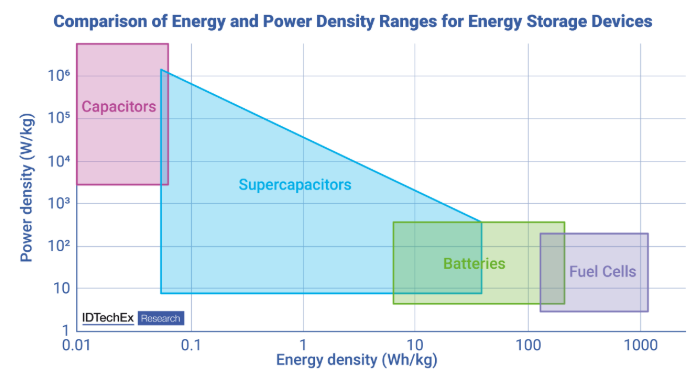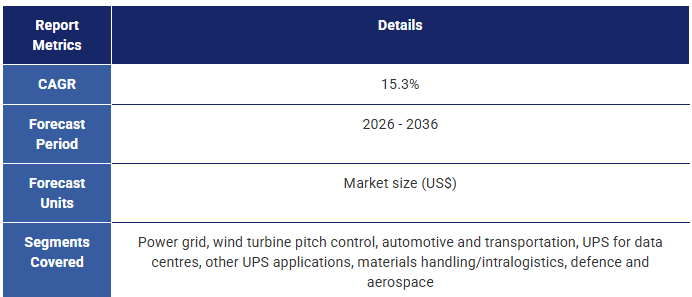スーパーキャパシター 2026-2036年:技術、応用分野、および市場予測Supercapacitors 2026-2036: Technologies, Applications and Forecasts 電気二重層スーパーキャパシター、疑似キャパシター、およびハイブリッドスーパーキャパシターを対象とした市場分析と10年予測。自動車、電力網、UPSを含む7つの市場セクターに分類されています。 ... もっと見る

サマリー
電気二重層スーパーキャパシター、疑似キャパシター、およびハイブリッドスーパーキャパシターを対象とした市場分析と10年予測。自動車、電力網、UPSを含む7つの市場セクターに分類されています。
この報告書は、スーパーキャパシター市場に関する洞察と市場情報を提供し、3種類のスーパーキャパシター(電気二重層スーパーキャパシター、疑似キャパシター、ハイブリッドスーパーキャパシター)を含む市場動向を分析しています。予測期間は2026年から2036年までの10年間を対象とし、スーパーキャパシターに関するこれまでで最も包括的な市場分析を提供しています。自動車/輸送、電力網、無停電電源装置(UPS)を含む7つの市場セグメントをカバーしています。例示製品と主要企業の分析も含まれています。
スーパーキャパシタの種類
本報告書では、スーパーキャパシタ/ウルトラキャパシタを、充電貯蔵メカニズムと電気化学的特性によって区別される3つの主要なカテゴリーに分類しています:
スーパーキャパシターのニッチ市場
スーパーキャパシターは、バッテリーとコンデンサの中間的な役割を果たします。コンデンサのような極めて高い出力密度や、リチウムイオンバッテリーのような高いエネルギー密度を提供することはできませんが、比較的高い出力密度と低~中程度のエネルギー密度を兼ね備えており、多様なニッチな用途に適しています。スーパーキャパシターは低コスト/Wを実現できますが、コスト/Whは通常、リチウムイオンバッテリーよりも1桁大きい値となります。
スーパーキャパシターの市場は、高出力密度とサイクル寿命を必要とするアプリケーション向けに、従来のキャパシター技術が達成可能なエネルギー密度よりも高いエネルギー密度を要する分野です。
.png) スーパーキャパシターの応用分野
過去には、自動車/輸送分野がスーパーキャパシターの市場を主導してきました。具体的には、回生ブレーキ、スタート・ストップシステム、電気列車やトラムでの使用が主な応用分野でした。しかし、再生可能エネルギーシステムにおける周波数応答のための電力網応用は、2036年までに市場におけるより重要な部分を占めるようになると予想されています。この点については、報告書で詳細に説明されています。
材料搬送やイントラロジスティクス分野、データセンターや半導体製造における無停電電源装置(UPS)などの新興応用分野も、今後10年間で市場の大部分を占める見込みですが、これらの産業の総電力需要に制限されています。
予測と市場分析
本報告書は、現在までに最も包括的なスーパーキャパシター応用動向の予測を提供し、予測期間中にグローバルなスーパーキャパシター市場が年平均成長率(CAGR)15.3%で成長すると予測しています。この報告書は、エネルギー貯蔵装置の分野で専門知識を有するIDTechExのアナリストによる直接的なインタビューと企業プロファイリング、および議論を通じて作成されました。2026年から2036年までの10年間を対象とし、スーパーキャパシターの技術、材料、イノベーションの分析を含んでいます。企業分析と議論も含まれています。また、バッテリーや燃料電池などの他のエネルギー貯蔵装置と比較したスーパーキャパシターの優位性と欠点をベンチマークしています。
.png)
目次1. 概要
1.1. エネルギー貯蔵技術と応用ニーズの適合
1.2. コンデンサと電気二重層コンデンサ(EDLC)の比較
1.3. スーパーキャパシタとバッテリーの比較
1.4. 3種類のスーパーキャパシター
1.5. 3種類のスーパーキャパシターの比較
1.6. スーパーキャパシター用の材料
1.7. スーパーキャパシターの採用を阻害する要因
1.8. 技術開発の動向
1.9. スーパーキャパシターセルのサイズと市場応用との関係
1.10. スーパーキャパシターの市場セグメント
1.11. スーパーキャパシターの予測
1.12. 予測の仮定と方法論
1.13. 2024年のスーパーキャパシター市場
1.14. 2025年から2036年までのアプリケーション別スーパーキャパシター市場予測
1.15. スーパーキャパシターの結論
1.16. IDTechExサブスクリプションでさらに多くの情報を入手
2. スーパーキャパシターの概要
2.1. アプリケーションの要件に合ったエネルギー貯蔵技術的??
2.2. スーパーキャパシターはバッテリーと従来のキャパシターの間を埋める
2.3. スーパーキャパシターとフライホイール
2.4. キャパシタンスとは何か?
2.5. 従来のコンデンサとスーパーキャパシタの比較
2.6. コンデンサと電気二重層コンデンサ(EDLC)の比較
2.7. コンデンサとスーパーキャパシタの容量と電圧範囲
2.8. エネルギー貯蔵技術の比較
2.9. スーパーキャパシタとバッテリーの比較
2.10. スーパーキャパシタとは何か?
2.11. 3種類のスーパーキャパシター
2.12. 3種類のスーパーキャパシターの比較
2.13. 電気二重層スーパーキャパシター(EDLC)と従来型キャパシターの比較
2.14. 充電貯蔵メカニズム(1)
2.15. 電荷貯蔵メカニズム(2)
2.16. エネルギー密度と出力密度の式
2.17. スーパーキャパシターのサービス寿命特性
2.18. スーパーキャパシターにおける電極材料の種類を区別する
2.19. 3種類の擬似キャパシタンスメカニズム
2.20. ハイブリッドスーパーキャパシタの種類
2.21. スーパーキャパシタの設計 - 対称型 vs 非対称型
2.22. リチウムイオンハイブリッドスーパーキャパシタ
2.23. スーパーキャパシタの物理的構造
2.24. スーパーキャパシタの材料
2.25. 炭素系電極材料 (1)
2.26. 炭素系電極材料 (2)
2.27. 遷移金属酸化物電極材料
2.28. 導電性ポリマー電極材料
2.29. 擬似キャパシタンス材料 - 内在的 vs 外在的
2.30. 電極材料の比較
2.31. 複合電極材料
2.32. 先進電極材料
2.33. 電解質材料の概要
2.34. 電解質における重要な要因
2.35. 有機系と水系液体電解質
2.36. アセトニトリル超電容器の安全対策
2.37. セパレーター材料
2.38. セパレーターに対する主要な要件
2.39. セパレーター材料の種類
2.40. 電流収集体
2.41. 金属系電流収集体のカスタマイズ
2.42. 超電容器におけるバインダーの役割
3. 市場動向
3.1. 自動車分野におけるスーパーキャパシターの商業例
3.2. 技術開発の動向
3.3. アサヒカセイのLi-ionキャパシターへの参入
3.4. セルサイズ別市場動向(1)
3.5. セルサイズ別市場動向(2)
3.6. 市場セグメント別プレイヤー動向
3.7. スーパーキャパシター業界への新規参入企業
3.8. 市場応用別スーパーキャパシターの採用状況
4. 市場予測
4.1. 予測の仮定と方法論
4.2. 2024年のスーパーキャパシター市場
4.3. 2025年から2036年までのアプリケーション別スーパーキャパシター市場予測
4.4. スーパーキャパシターに関する結論
5. スーパーキャパシターの応用
5.1. スーパーキャパシターセルのサイズと市場応用との関係
5.2. スーパーキャパシターの市場セグメント
5.3. 小型・コンパクトデバイス用のスーパーキャパシター
5.4. Korchip
5.5. LEDドライバー用のスーパーキャパシター
5.6. バーコードスキャナー用のスーパーキャパシター
5.7. ソリッドステートドライブのバックアップ電源用スーパーキャパシター
5.8. 小型電子機器用スーパーキャパシター
5.9. ケーススタディ:Ligna Energy
5.10. ケーススタディ:Ligna Energy製品シリーズ
5.11. 医療用アプリケーション向けスーパーキャパシター
5.12. フレキシブルスーパーキャパシター(1)
5.13. フレキシブルスーパーキャパシター(2)
5.14. 自動車・輸送分野の応用
5.15. 自動車応用向けスーパーキャパシター(1)
5.16. 自動車応用向けスーパーキャパシター(2)
5.17. 自動車用アプリケーション向けのスーパーキャパシターバックアップ電源
5.18. エンジン始動用アプリケーション向けのスーパーキャパシター
5.19. 鉛酸電池に対する監視の強化
5.20. パワートレインのオプションとその特徴
5.21. Riversimple:スーパーキャパシターを搭載した燃料電池電気自動車
5.22. Clarios:自動車用アプリケーションにおけるスーパーキャパシターとバッテリーの組み合わせ
5.23. 高電圧への傾向
5.24. 輸送用スーパーキャパシター(1)
5.25. 輸送用スーパーキャパシター(2)
5.26. 寧波CRRC新エネルギー技術有限公司
5.27. 超電容器駆動の電気フェリー
5.28. 産業用アプリケーション向けのスーパーキャパシター
5.29. 風力タービンのピッチ制御用スーパーキャパシター
5.30. 鉱山電気化向けのスーパーキャパシター関連技術
5.31. 材料搬送とイントラロジスティクス用のスーパーキャパシター (1)
5.32. 材料搬送とイントラロジスティクス用のスーパーキャパシター (2)
5.33. 材料搬送とイントラロジスティクス用のスーパーキャパシター (3)
5.34. アルミニウムデータセンターのピークシェービング用スーパーキャパシター
5.35. ミッションクリティカルなアプリケーション向けスーパーキャパシターベースの電源バックアップソリューション
5.36. エネルギー・ユーティリティ分野におけるスーパーキャパシター
5.37. 太陽光・風力発電向けスーパーキャパシター
5.38. ハイブリッドエネルギー貯蔵システム(HESS)
5.39. 例:バッテリー・スーパーキャパシターハイブリッドエネルギー貯蔵システム
5.40. 波力・潮力エネルギーの回収用スーパーキャパシター
5.41. 周波数応答用スーパーキャパシター
5.42. 電力網応用向けスーパーキャパシター
5.43. 強化型静止同期補償器(E-STATCOM)
5.44. 例:スーパーキャパシターを用いた無効電力補償システム
5.45. ケーブル型スーパーキャパシター
5.46. 燃料電池用固定式電源向けスーパーキャパシター
5.47. マイクログリッド応用向けスーパーキャパシター
5.48. EV向けスーパーキャパシターベースの急速充電ステーション概念
5.49. 核融合産業におけるスーパーキャパシター
5.50. 軍事・航空宇宙分野向けスーパーキャパシター
5.51. 軍事・航空宇宙分野向けスーパーキャパシター
5.52. 航空産業向けスーパーキャパシター
5.53. 衛星向けスーパーキャパシター
5.54. 軍事応用向けスーパーキャパシター(1)
5.55. 軍事応用向けスーパーキャパシター(2)
6. ケーススタディ
6.1. ニッポン・ケミコン株式会社
6.2. ニッポン・ケミコン スーパーキャパシター製品シリーズ
6.3. スケルトン・テクノロジーズ
6.4. スケルトン・テクノロジーズ 製品シリーズ (1)
6.5. スケルトン・テクノロジーズ 製品シリーズ (2)
6.6. スケルトン・テクノロジーズ - 曲面グラフェン
6.7. スケルトン・テクノロジーズの研究開発活動
6.8. ムサシ・エナジー・ソリューションズ
6.9. ムサシ・エナジー・ソリューションズのターゲット産業
6.10. ムサシ・エナジー・ソリューションズ製品シリーズ
6.11. SECH SA
6.12. SECH SA製品シリーズ
7. 企業プロファイル
7.1. 関連企業プロファイル一覧。
Summary
Market analysis and ten-year forecast covering electric double-layer supercapacitors, pseudocapacitors and hybrid supercapacitors, segmented into seven market sectors including automotive, power grid and UPS
This report provides insight and market intelligence into the market for supercapacitors including three supercapacitor types (electric double-layer supercapacitors, pseudo-capacitors and hybrid supercapacitors). The forecast covers a ten-year period from 2026-2036, and forms the most comprehensive market analysis to date on supercapacitors, covering seven market segments, including automotive/transport, power grid and uninterruptible power supply (UPS). Example products and player analysis are also included.
Supercapacitor types
The report recognizes three broad categories of supercapacitors/ultracapacitors, which are distinguished both by their charge storage mechanisms and their electrochemical properties:
The niche for supercapacitors
Supercapacitors act as an interim between batteries and capacitors. They are unable to provide the extremely high power density of capacitors or the higher energy density of a lithium-ion battery, however they offer reasonably high power density and low-moderate energy density, which makes them suitable for a variety of niche applications. Supercapacitors can achieve a low cost/W but the cost/Wh is usually an order of magnitude greater than that of lithium-ion batteries.
The niche for supercapacitors is for applications requiring high power density and cycle life but higher energy density than conventional capacitor technologies are able to achieve.
 Supercapacitor applications
In the past, automotive/transport applications dominated the market for supercapacitors, specifically regenerative braking, start-stop systems, and for use in electric trains and trams. However, power grid applications for frequency response in renewable energy systems are expected to grow to be a more significant part of the market by 2036, as is explored in more detail in the report.
Other emerging applications in materials handling and intralogistics and for uninterruptible power supply in data centers and semiconductor manufacturing are expected to also be significant portions of the market over the next decade, though they are limited by the total power demand of these industries.
Forecasts and market analysis
This report provides the most comprehensive forecast of supercapacitor application trends to date, and predicts a CAGR of 15.3% for the global supercapacitor market over the forecast period. It was produced through direct interviewing and profiling of players and discussions between IDTechEx analysts with expertise in energy storage devices. It covers a ten year period between 2026 and 2036 and includes a breakdown of supercapacitor technologies, materials and innovations. Player analysis and discussion is also included. The report also benchmarks the advantages and disadvantages of supercapacitors compared with other energy storage devices, such as batteries and fuel cells.
Table of Contents1. EXECUTIVE SUMMARY
1.1. Matching energy storage technologies to application needs
1.2. Comparing capacitors with electric double layer capacitors (EDLCs)
1.3. Supercapacitors vs batteries
1.4. Three types of supercapacitors
1.5. Comparing three types of supercapacitors
1.6. Materials for supercapacitors
1.7. Factors negatively impacting supercapacitor adoption
1.8. Technology development trends
1.9. Relating supercapacitor cell size with market applications
1.10. Market segments for supercapacitors
1.11. Supercapacitor predictions
1.12. Forecast assumptions and methodology
1.13. Supercapacitor market 2024
1.14. Supercapacitor market forecast by application 2025-2036
1.15. Supercapacitor conclusions
1.16. Access More With an IDTechEx Subscription
2. INTRODUCTION TO SUPERCAPACITORS
2.1. Matching energy storage technologies to application needs
2.2. Supercapacitors bridge the gap between batteries and conventional capacitors
2.3. Supercapacitors vs flywheels
2.4. What is capacitance ?
2.5. Conventional capacitors vs supercapacitors
2.6. Comparing capacitors with electric double layer capacitors (EDLCs)
2.7. Capacitance and voltage ranges for capacitors and supercapacitors
2.8. Comparisons between energy storage technologies
2.9. Supercapacitors vs batteries
2.10. What are supercapacitors?
2.11. Three types of supercapacitors
2.12. Comparing three types of supercapacitors
2.13. Electric double-layer supercapacitors (EDLCs) vs conventional capacitors
2.14. Charge storage mechanisms (1)
2.15. Charge storage mechanisms (2)
2.16. Equations for energy density and power density
2.17. Supercapacitor service life characteristics
2.18. Distinguish the type of electrode materials in supercapacitors
2.19. Three types of pseudocapacitance mechanisms
2.20. Types of hybrid supercapacitors
2.21. Design of supercapacitors - symmetric vs asymmetric
2.22. Li-ion hybrid supercapacitors
2.23. Physical structures of supercapacitors
2.24. Materials for supercapacitors
2.25. Carbon-based electrode materials (1)
2.26. Carbon-based electrode materials (2)
2.27. Transition metal oxide electrode materials
2.28. Conducting polymer electrode materials
2.29. Pseudocapacitive materials - intrinsic vs extrinsic
2.30. Comparing electrode materials
2.31. Composite electrode materials
2.32. Advance electrode materials
2.33. Electrolyte materials overview
2.34. Important factors for electrolytes
2.35. Organic vs aqueous liquid electrolytes
2.36. Safety considerations with acetonitrile supercapacitors
2.37. Separator materials
2.38. Key requirements for separators
2.39. Types of separator materials
2.40. Current collectors
2.41. Modification of metal-based current collectors
2.42. The role of binders in supercapacitors
3. PLAYER LANDSCAPE
3.1. Some commercial examples on supercapacitors in automotive
3.2. Technology development trends
3.3. Asahi Kasei's involvement in Li-ion capacitor
3.4. Player landscape by cell size (1)
3.5. Player landscape by cell size (2)
3.6. Player landscape by market segment
3.7. Recent entrants into the supercapacitor industry
3.8. Supercapacitor adoption by market application
4. MARKET FORECASTS
4.1. Forecast assumptions and methodology
4.2. Supercapacitor market 2024
4.3. Supercapacitor market forecast by application 2025-2036
4.4. Supercapacitor conclusions
5. SUPERCAPACITOR APPLICATIONS
5.1. Relating supercapacitor cell size with market applications
5.2. Market segments for supercapacitors
5.3. Supercapacitors for small and compact devices
5.4. Korchip
5.5. Supercapacitors for LED drivers
5.6. Supercapacitors for barcode scanners
5.7. Supercapacitors for backup power in solid-state drives
5.8. Supercapacitors in small electronic devices
5.9. Case study: Ligna Energy
5.10. Case study: Ligna Energy product series
5.11. Supercapacitors for medical applications
5.12. Flexible supercapacitors (1)
5.13. Flexible supercapacitors (2)
5.14. Applications for automotive & transportation
5.15. Supercapacitors for automotive applications (1)
5.16. Supercapacitors for automotive applications (2)
5.17. Supercapacitors backup power supply for automotive applications
5.18. Supercapacitors for engine-starting applications
5.19. Increasing scrutiny on lead-acid batteries
5.20. Powertrain options and their features
5.21. Riversimple: Fuel cell electric vehicles equipped with supercapacitors
5.22. Clarios: Pairing supercapacitors with batteries for automotive applications
5.23. Trending towards higher voltage
5.24. Supercapacitors for transportation (1)
5.25. Supercapacitors for transportation (2)
5.26. Ningbo CRRC New Energy Technology Co., Ltd.
5.27. Ultracapacitor-powered electric ferry
5.28. Supercapacitors for industrial applications
5.29. Supercapacitors for pitch control in wind turbines
5.30. Supercapacitor-related technologies for mining electrification
5.31. Supercapacitors for materials handling and intralogistics (1)
5.32. Supercapacitors for materials handling and intralogistics (2)
5.33. Supercapacitors for materials handling and intralogistics (3)
5.34. Supercapacitors for Al data center peak shaving
5.35. Supercapacitor-based power backup solution for mission-critical applications
5.36. Supercapacitors in the energy & utility sector
5.37. Supercapacitor for solar and wind power
5.38. Hybrid Energy Storage Systems (HESS)
5.39. Example: Battery-supercapacitor hybrid energy storage systems
5.40. Supercapacitors to capture wave and tidal energy
5.41. Supercapacitors for frequency response
5.42. Supercapacitor for power grid applications
5.43. Enhanced static synchronous compensator (E-STATCOM)
5.44. Example: Reactive power compensation systems with supercapacitors
5.45. Cable-based supercapacitors
5.46. Supercapacitors for fuel cell stationary power
5.47. Supercapacitors for microgrid applications
5.48. Supercapacitor-based fast-charging station concept for EVs
5.49. Supercapacitors in the nuclear fusion industry
5.50. Supercapacitors for military & aerospace applications
5.51. Supercapacitors for military & aerospace applications
5.52. Supercapacitors for the aviation industry
5.53. Supercapacitors for satellites
5.54. Supercapacitors for military applications (1)
5.55. Supercapacitors for military applications (2)
6. CASE STUDIES
6.1. Nippon Chemi-Con Corporation
6.2. Nippon Chemi-Con supercapacitor product series
6.3. Skeleton Technologies
6.4. Skeleton Technologies product series (1)
6.5. Skeleton Technologies product series (2)
6.6. Skeleton Technologies - curved graphene
6.7. Skeleton Technologies R&D activities
6.8. Musashi Energy Solutions
6.9. Musashi Energy Solutions' target industries
6.10. Musashi Energy Solutions product series
6.11. SECH SA
6.12. SECH SA product series
7. COMPANY PROFILES
7.1. Linked company profiles list
ご注文は、お電話またはWEBから承ります。市場調査レポートのお見積もり作成・購入の依頼もお気軽にご相談ください。本レポートと同分野(エネルギー貯蔵)の最新刊レポートIDTechEx社の 自動車 - Vehicles分野 での最新刊レポート
よくあるご質問IDTechEx社はどのような調査会社ですか?IDTechExはセンサ技術や3D印刷、電気自動車などの先端技術・材料市場を対象に広範かつ詳細な調査を行っています。データリソースはIDTechExの調査レポートおよび委託調査(個別調査)を取り扱う日... もっと見る 調査レポートの納品までの日数はどの程度ですか?在庫のあるものは速納となりますが、平均的には 3-4日と見て下さい。
注文の手続きはどのようになっていますか?1)お客様からの御問い合わせをいただきます。
お支払方法の方法はどのようになっていますか?納品と同時にデータリソース社よりお客様へ請求書(必要に応じて納品書も)を発送いたします。
データリソース社はどのような会社ですか?当社は、世界各国の主要調査会社・レポート出版社と提携し、世界各国の市場調査レポートや技術動向レポートなどを日本国内の企業・公官庁及び教育研究機関に提供しております。
|
|






